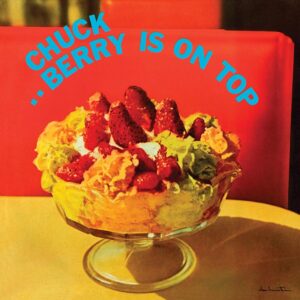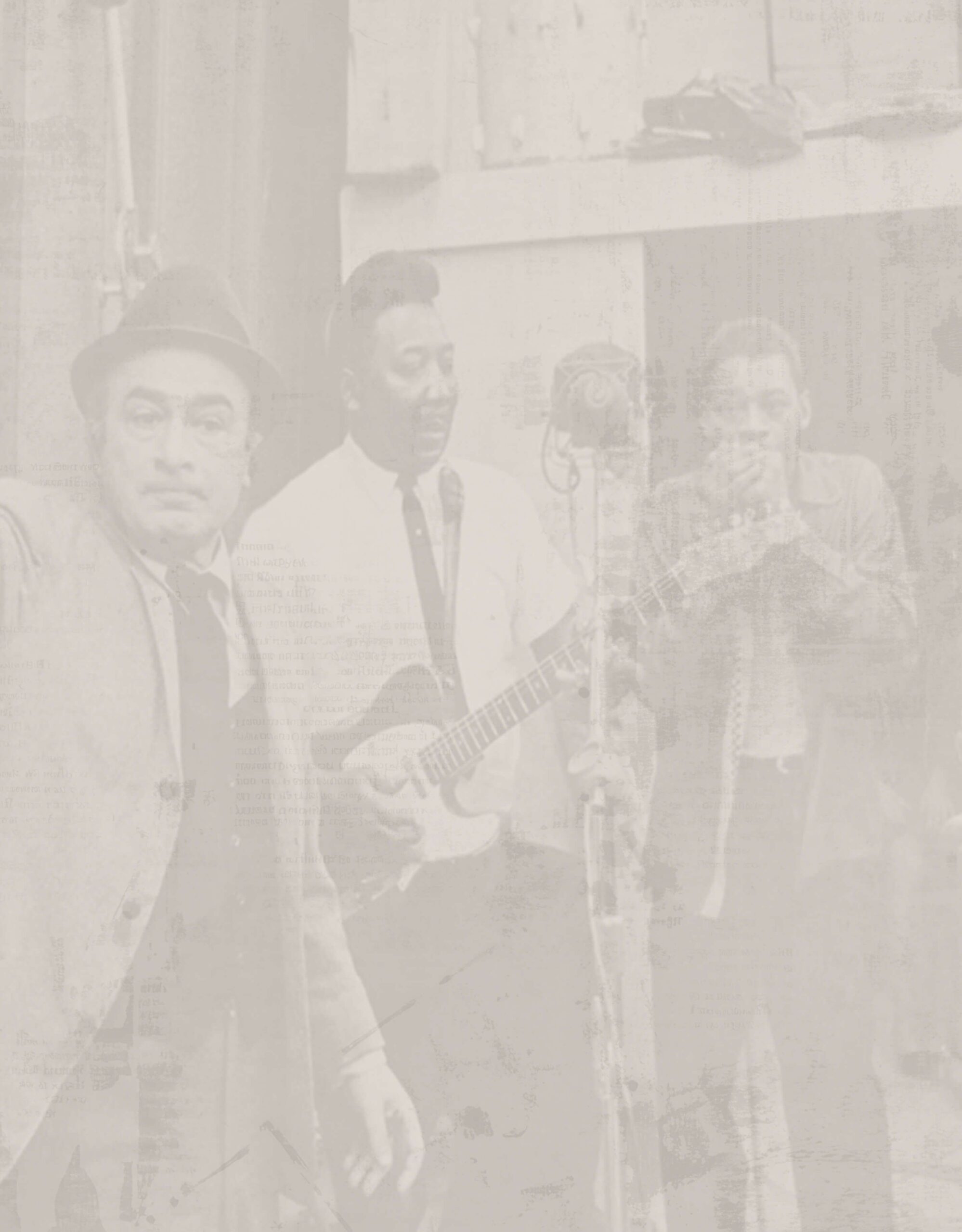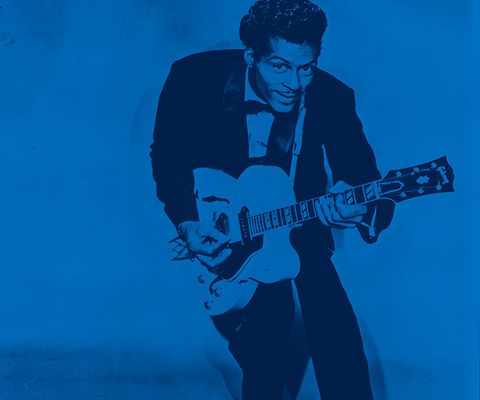Chuck Berry
Chuck Berry
“If you tried to give rock and roll another name, you might call it ‘Chuck Berry.’” - John Lennon
Somewhere in the vast reaches of our galaxy, etched into the grooves of a golden record launched aboard the Voyager space probe in 1977, is Chuck Berry’s immortal Chess recording of “Johnny B. Goode.” Alongside works by Bach, Beethoven, Mozart and other composers around the world, it waits to introduce life on other planets to the sound of rock and roll. Such is the power of Berry, who synthesized blues and country into a boisterous style that became the shorthand for popular music for decades to come.
Berry was born into a middle-class family in St. Louis, Missouri in 1926 - the son of a father who served as the deacon of a local Baptist church and a school principal mother. In high school, he’d already proven himself a steady hand on the guitar, but served a three-year sentence at a reformatory after being convicted of armed robbery. Upon release, he found steady work in local factories - earning enough to buy a house for his wife and daughter - and supplemented his income with club gigs that showcased his guitar playing and uncanny showmanship.
The standout aspects of Berry’s work as a musician - from the electric clarity of his instrument to head turning onstage moves like his one-legged “duck walk” - would soon become impossible to ignore. In 1955, fellow guitarist Muddy Waters suggested he look up the Chess Records label in Chicago to see what their response to his tunes would be. Leonard Chess was particularly thrilled by Berry’s rendition of the country standard “Ida Mae,” which Berry would record with new lyrics and the title “Maybellene.” The single became his first million seller, topping the Billboard R&B charts and reaching No. 5 on the overall singles chart. “Roll Over Beethoven” became his next chart hit in 1956, followed by a string of Top 10 singles on the Billboard Hot 100: 1957’s “School Days” and “Rock and Roll Music,” and 1958’s “Sweet Little Sixteen” and the genre-defining “Johnny B. Goode.”
While Berry’s popularity was challenged in the early ‘60s by a three-year prison sentence, he was released into a record business that viewed his music as a North Star. A new wave of British acts from The Beatles to The Rolling Stones were covering his songs, while American group The Beach Boys adapted “Sweet Little Sixteen” into the hits “Surfin’ U.S.A.” Berry soon began releasing new hits of his own like “Nadine,” “No Particular Place to Go” and “You Never Can Tell.” He remained an in-demand performer on the concert circuit, and in 1972 scored his only No. 1 hit with the novelty song “My Ding-a-Ling.”
As decades passed, Chuck Berry remained a living institution of rock and roll. In 1985, a new generation was re-introduced to “Johnny B. Goode” in a pivotal scene of the blockbuster comedy Back to the Future. A year later, Berry became the first inductee into the Rock and Roll Hall of Fame and starred in Hail! Hail! Rock and Roll, a documentary concert film that saw him play a star-studded 60th birthday performance with guest turns from Keith Richards of The Rolling Stones, Eric Clapton, Etta James, Linda Ronstadt and others. “Maybellene” and “Johnny B. Goode” were each inducted into the Grammy Hall of Fame in 1988 and 1999, and “Roll Over Beethoven” was added to the Library of Congress’ National Recording Registry in 2003. Chuck Berry continued to embody the spirit of rock and roll all the way up to the 2017 album Chuck, released three months after the guitar legend passed away at the age of 90.
Somewhere in the vast reaches of our galaxy, etched into the grooves of a golden record launched aboard the Voyager space probe in 1977, is Chuck Berry’s immortal Chess recording of “Johnny B. Goode.” Alongside works by Bach, Beethoven, Mozart and other composers around the world, it waits to introduce life on other planets to the sound of rock and roll. Such is the power of Berry, who synthesized blues and country into a boisterous style that became the shorthand for popular music for decades to come.
Berry was born into a middle-class family in St. Louis, Missouri in 1926 - the son of a father who served as the deacon of a local Baptist church and a school principal mother. In high school, he’d already proven himself a steady hand on the guitar, but served a three-year sentence at a reformatory after being convicted of armed robbery. Upon release, he found steady work in local factories - earning enough to buy a house for his wife and daughter - and supplemented his income with club gigs that showcased his guitar playing and uncanny showmanship.
The standout aspects of Berry’s work as a musician - from the electric clarity of his instrument to head turning onstage moves like his one-legged “duck walk” - would soon become impossible to ignore. In 1955, fellow guitarist Muddy Waters suggested he look up the Chess Records label in Chicago to see what their response to his tunes would be. Leonard Chess was particularly thrilled by Berry’s rendition of the country standard “Ida Mae,” which Berry would record with new lyrics and the title “Maybellene.” The single became his first million seller, topping the Billboard R&B charts and reaching No. 5 on the overall singles chart. “Roll Over Beethoven” became his next chart hit in 1956, followed by a string of Top 10 singles on the Billboard Hot 100: 1957’s “School Days” and “Rock and Roll Music,” and 1958’s “Sweet Little Sixteen” and the genre-defining “Johnny B. Goode.”
While Berry’s popularity was challenged in the early ‘60s by a three-year prison sentence, he was released into a record business that viewed his music as a North Star. A new wave of British acts from The Beatles to The Rolling Stones were covering his songs, while American group The Beach Boys adapted “Sweet Little Sixteen” into the hits “Surfin’ U.S.A.” Berry soon began releasing new hits of his own like “Nadine,” “No Particular Place to Go” and “You Never Can Tell.” He remained an in-demand performer on the concert circuit, and in 1972 scored his only No. 1 hit with the novelty song “My Ding-a-Ling.”
As decades passed, Chuck Berry remained a living institution of rock and roll. In 1985, a new generation was re-introduced to “Johnny B. Goode” in a pivotal scene of the blockbuster comedy Back to the Future. A year later, Berry became the first inductee into the Rock and Roll Hall of Fame and starred in Hail! Hail! Rock and Roll, a documentary concert film that saw him play a star-studded 60th birthday performance with guest turns from Keith Richards of The Rolling Stones, Eric Clapton, Etta James, Linda Ronstadt and others. “Maybellene” and “Johnny B. Goode” were each inducted into the Grammy Hall of Fame in 1988 and 1999, and “Roll Over Beethoven” was added to the Library of Congress’ National Recording Registry in 2003. Chuck Berry continued to embody the spirit of rock and roll all the way up to the 2017 album Chuck, released three months after the guitar legend passed away at the age of 90.



